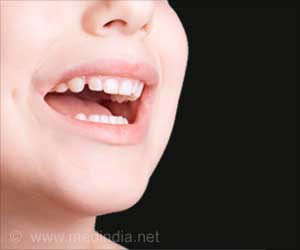
Baby Teeth May Signal Mental Health Disorder Risk in Later Life
The timing of these adverse events and how they affect a child’s development were unknown due to a lack of effective tools.
Knowing that anthropologists have studied people’s teeth from past eras to learn more about their lives, researchers thought that tooth formation would create a permanent record of different kinds of life experiences.
New teeth begin to erupt in the mouth when babies are between 6 and 12 months old. In some cases, babies are born with an already erupted tooth.
When such newly formed tooth is exposed to sources of physical stress, such as poor nutrition or disease, they cause marked changes in growth lines within teeth, called stress lines, which are similar to the rings in a tree bark that marks its age.
Tooth growth lines can also vary based on the environment and experiences a child has inside a womb and, shortly after the birth, the time when teeth are forming. Thicker growth lines are thought to indicate more stressful life conditions.
New Theory
Based on these facts, researchers theorized that the width of one variety of growth lines is called the neonatal line (NNL), which could indicate whether an infant’s mother experienced high levels of psychological stress during pregnancy and in the period after birth.
To prove this theory, they analyzed 70 baby teeth collected from 70 children enrolled in the Avon Longitudinal Study of Parents and Children (ALSPAC) in the United Kingdom. In ALSPAC, parents donated primary teeth that naturally fell out of the mouths of children aged 5 to 7.
Mothers completed questionnaires regarding factors that are known to affect child development during and shortly after pregnancy, such as:
- Stressful events that occurred during pregnancy.
- History of psychological problems in mother.
- Surrounding environment quality (whether the poverty level was high, or it was unsafe).
- Level of social support.
The results of the questionnaire showed that children whose mothers had lifetime histories of severe depression or other psychiatric problems and who experienced depression or anxiety at 32 weeks of pregnancy were more likely to have thicker NNLs than others.
Mothers who received essential social support shortly after pregnancy tended to have thinner NNLs.
This pattern remained the same even after controlling other factors that influence NNLs width, including iron supplementation during pregnancy, gestational age (the time between conception and birth), and maternal obesity.
“No one is certain what causes the NNL to form, but a mother experiencing anxiety or depression may produce more cortisol, the ‘stress hormone,’ which interferes with the cells that create enamel. Systemic inflammation is another candidate” said, Erin C. Dunn, ScD, MPH, social and psychiatric epidemiologist and an investigator in MGH’s Psychiatric and Neurodevelopmental Genetics Unit.
If the findings of this research can be replicated in a larger study, then NNL and other tooth growth marks can be used in the future to identify children who have been exposed to early life adversity.
Then interventions can be provided to children for preventing the onset of mental health disorders and should do that as early as possible in the lifespan.
How to Prevent Adverse Childhood Experiences?
- Strengthening economic support for families.
-
Promote campaigns that protect against violence and adversity. -
Ensure high-quality child care and preschool enrichment with family engagement. -
Teach skills that help parents to handle stress, manage emotions, and tackle everyday challenges. -
Connect youth to caring adults and activities. -
Interventions that lessen immediate and long-term harms -
Enhanced primary care. -
Victim-centered services. -
Treatment to prevent problem behavior and future involvement in violence. -
Family-centered therapy for substance use disorders.
References
- Preventing Adverse Childhood
Experiences (ACEs):
Leveraging the Best Available Evidence – (https://www.cdc.gov/violenceprevention/pdf/preventingACES.pdf) - Childhood Adversity: Buffering Stress & Building Resilience – (https://www.healthychildren.org/English/healthy-living/emotional-wellness/Building-Resilience/Pages/ACEs-Adverse-Childhood-Experiences.aspx)
- Screening for childhood adversity: The what and when of identifying individuals at risk for lifespan health disparities
– (https://www.ncbi.nlm.nih.gov/pmc/articles/PMC6031456/) - Neonatal line as a linear evidence of live birth: Estimation of postnatal survival of a new born from primary tooth germs
– (https://www.researchgate.net/publication/51737468_Neonatal_line_as_a_linear_evidence_of_live_birth_Estimation_of_postnatal_survival_of_a_new_born_from_primary_tooth_germs)
Source: Medindia
Stay connected with us on social media platform for instant update click here to join our Twitter, & Facebook
We are now on Telegram. Click here to join our channel (@TechiUpdate) and stay updated with the latest Technology headlines.
For all the latest Health News Click Here
For the latest news and updates, follow us on Google News.

